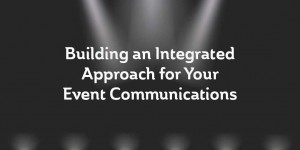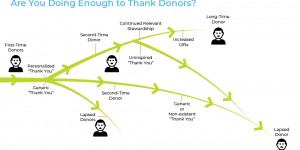In order to communicate effectively with your donor base, you need to know at least a little bit about them. This means to create meaningful personalized materials, your organization will need to have at least some donor data on hand. The good news is that you only need a small amount of data to get started with personalized content. You probably even already have a basic set of data about most of your donor base!
In fact, 80 percent of organizations use a single data point when targeting their donors. This figure can provide some comfort to those who have not yet began using their donor data to communicate with constituents more effectively. However, using only one piece of donor data when targeting communications leaves a lot to be explored and utilized.
In most cases, this single data point is likely an individual’s past giving history. You can expand upon even this simple piece of data to include actual dollars donated and frequency of donations. Of course, this is assuming the organization is only currently sorting potential donors into the categories of previous donors and non-donors. Your organization probably already has this data available, so it’s a great place to jump start your personalization efforts.
Expanding on the data points your organization utilizes will allow you to hyper-focus your targeting. In turn, this makes communications even more relevant and intimate for each individual. Some other data points nonprofit organizations commonly utilize include location, personal interests, how their relationship with the organization began. They also focus on donor data such as biographical information, including preferred first name and age, and educational background.
With Great Data Comes Great Responsibility
It seems like every time we turn on the news there is another story about a major data breach.The practice of selling collected data, including information gained from web browsing history, to third parties appears to have become common. I’m sure you’ve had the experience of googling a particular product, only to have the same item show up in an ad on social media later that day.
As the public becomes more aware of how much data is available about them and how accessible it can be, many have gown skeptical of handing over their personal information. However, you can take some steps to ensure that your donors feel secure with their data in your hands.
Adding an official privacy statement on any materials that are designed to gather donor information is a good first step. This statement should explain your organization’s data security procedures. It should assure your donor base that you will not sell their information to a third party. If you don’t already have one, a privacy statement can go a long way towards building trust and giving your donors some piece of mind. It will also remind them that you care about their sensitive information.
Handling Donor Data
When using personalization strategies supported by donor data, it is important to understand the fine line between personal and creepy. Making mention of giving habits, history, and personal interest is more than fine. However, if you obtain some sensitive information about a donor you would not feel comfortable sharing about yourself, don’t use it.
If you just read through this blog post and felt lost, please check out our previous post in our series on personalization. The first post in this series covers why your organization needs to use personalization to create compelling, individualized content. If you found this information helpful, be sure to follow Action Graphics on Facebook, LinkedIn, and Twitter, and check back here for out next post! Also, keep your eyes peeled for a future blog series for a more in depth discussion on donor data.







